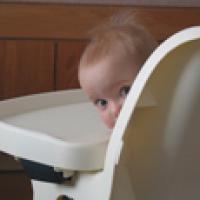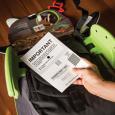Can Your High Chair Be Dangerous?

Many parents assume the high chair they use for their child during meal time is safe. Unfortunately, that is not always the case. Our new research shows that every day in the U.S., an average of 24 children are treated in an emergency department for an injury related to either a high chair or chair booster seat – that is one child every hour.
The majority of injuries are the result of a fall - either because the safety restraints were not used or because they were too loose. Falls from high chairs can be dangerous because high chairs are usually used in kitchens and dining areas which often have hard flooring such as tile or wood. If a child falls head first onto these hard surfaces, serious injuries can occur. When used correctly, however, high chairs and booster seats can be great tools to help meal time go smoothly. The following tips can help make meal time safe for all.
Selecting A High Chair
Sturdy
Look for a high chair with a wide base that does not feel “wobbly” or “flimsy.” Some high chairs have locking mechanisms. Make sure you hear and feel this locking mechanism click into place when you set up the chair, when you adjust the seat and when you snap the tray into place. If the high chair has wheels, make sure they are also locked before you place your child in the seat.
Certified
The JPMA (Juvenile Products Manufacturers Association) certifies that high chairs meet ASTM International safety standards. Products that meet the established standards will have the JPMA Certified seal either on the high chair itself, on the box, or in the chair’s instruction manual.
Check for recalls
To be sure your high chair is safe, check www.recalls.gov to see if it has been recalled because of injury hazards. Millions of unsafe high chairs have been recalled during recent years.
Tips for Safe Use
- Always use the safety restraints. Most high chair-related injuries can be prevented by correctly using the safety restraints every time your child is in the seat. Make sure all the straps are buckled, including the crotch strap if there is one, and make sure the straps fit snugly against your child. If he can wiggle out of the strap, it is not tight enough. Also make it a rule that high chairs are for sitting only – no standing, climbing or playing on the chair should be allowed.
- Keep the area around the high chair clear. Keep tablecloths, placemats, sharp silverware, plates and hot food/liquids out of your child’s reach. Also make sure that the high chair is not too close to the table, a counter or the wall. A child can knock over a high chair by kicking their feet into these objects.
- Stay with your child during meal time. An unsupervised child is more likely to try to escape from the high chair or choke on his/her food. Use meal time to spend some enjoyable time with your child.
For more information on high chair injuries and how to prevent them, visit Nationwide Children's Hospital's web page.
Dr. Gary Smith is a Professor of Pediatrics, Emergency Medicine and Epidemiology at The Ohio State University. He is founder and director of the Center for Injury Research and Policy of The Research Institute at Nationwide Children’s Hospital. Dr. Smith is board certified in the specialties of pediatrics and general preventive medicine and public health, and in the subspecialty of pediatric emergency medicine. In addition to his clinical training, he holds MPH and DrPH degrees from the Johns Hopkins University Bloomberg School of Public Health. Dr. Smith has been an active researcher in the field of injury for more than 25 years.




